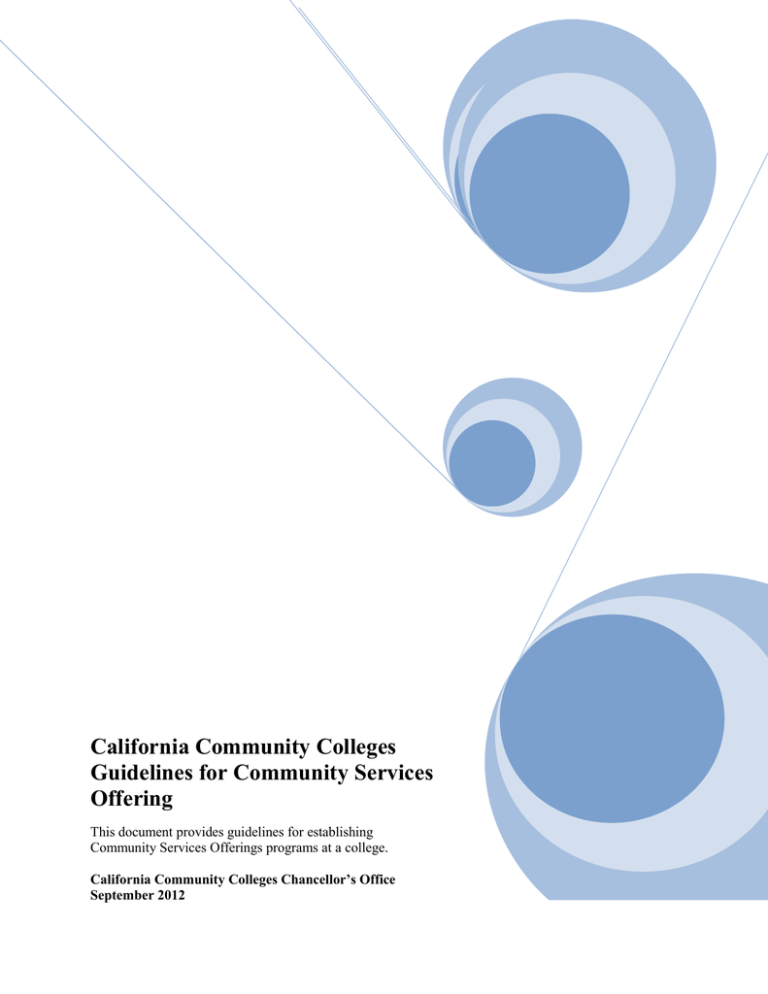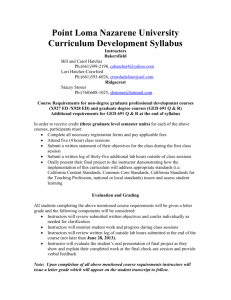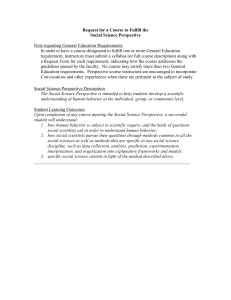California Community Colleges Guidelines for Community Services Offering
advertisement

California Community Colleges Guidelines for Community Services Offering This document provides guidelines for establishing Community Services Offerings programs at a college. California Community Colleges Chancellor’s Office September 2012 For questions regarding the Guidelines on Community Services Offering, please contact: Dr. Barry Russell, Vice Chancellor of Academic Affairs, California Community Colleges Chancellor’s Office at brussell@cccco.edu or 916-322-6886. Table of Contents I. Introduction ...................................................................................................................... 1 II. Definition of Terms .......................................................................................................... 2 III. Reasons to Offer Community Services Offerings................................................................. 2 Suggestions for Success ................................................................................................. 3 Statutory Requirements and Regulations to Create a Community Services Offering............................................................................................................................ 4 Best Practices in Administering a Community Services Offering ..................................... 5 Vision and Mission .................................................................................................... 5 Policies ...................................................................................................................... 6 Staffing ...................................................................................................................... 6 Record Keeping ......................................................................................................... 7 Class Formats............................................................................................................. 7 Marketing Strategies .................................................................................................. 8 Establishing a Community Services Offering ................................................................... 8 Community Services Offering Class Elements ........................................................... 8 Community Services Offering Class Approval Process.............................................. 10 Selection of Instructors and Other Providers .............................................................. 10 Community Services Offering Instructor Guide ......................................................... 10 Compensation of Instructors/Providers ...................................................................... 11 Payment Schedule for Instructors/Providers ............................................................... 11 Class Cost .................................................................................................................. 12 Student Registration ................................................................................................... 13 Refund Policy for Community Services Offerings ..................................................... 13 Facilities .................................................................................................................... 14 Customer Service Evaluation ..................................................................................... 14 VII. Combined Classes ............................................................................................................ 14 VIII. Contract Education ........................................................................................................... 15 IX. Resources ......................................................................................................................... 16 IV. V. VI. i California Community Colleges Chancellor’s Office Community Services Offering Guidelines September 2012 I. Introduction The purpose of these guidelines is to provide basic guidance as required by Education Code section 78300 for colleges contemplating or planning to add a Community Services Offering to their college or to expand an existing one. Community Services Offerings are also known as Community Education, Community Services, and Continuing Education, but for the purpose of these guidelines, it will be referred to only as Community Services Offering. The guidelines provide both suggested steps to consider during the implementation of a Community Services Offering and examples of best practices gathered from Community Services Offering programs at several community colleges throughout the state. Background The state’s fiscal condition has a direct impact on funding for community colleges. Any reductions in state funding require colleges to make difficult choices in how to prioritize course offerings, support services, make faculty hiring decisions, and consider new program development options. As colleges set priorities for program offerings in credit or noncredit classes, the option of transitioning some courses to a fee-based, Community Services Offering is one possibility colleges may consider. Community Services Offering class fees cover the direct costs of instruction such as instructor, supplies, field trips, and other class requirements. Class fees also cover relevant indirect administrative costs such as staff support, facility, rent, advertising, custodial, and heating, as determined by the local college. Community Services Offering classes provide no credit units and are offered outside the regular college credit and noncredit programs. Students who take Community Services Offering classes are not permitted to convert their classes for credit. Also, a Community Services Offering is not required to be included in the college’s catalog and does not generate full-time equivalent student (FTES) apportionment. This document was created by the Association of Community and Continuing Education (ACCE) with support from Chancellor's Office staff and was vetted through the System Advisory Committee on Curriculum (SACC) and the Consultation Council. This collaboration included a statewide survey of ACCE members and reflects the variety of implemented methods that might be employed. Community needs vary greatly throughout the state; therefore, it is important to remember that no single solution will fit every community. Flexibility is a key element to ensuring that a Community Services Offering is both self-sufficient and responsive. 1 II. Definition of Terms For the purpose of understanding title 5 related to a Community Services Offering, it is important to note the definitions of the following terms and how they are applied. Community Services Offering: A fee-supported, not-for-credit community services class authorized pursuant to Education Code section 78300 and approved pursuant to subdivision (d) of title 5, section 55002, for which state apportionment is not claimed and credit is not awarded (title 5, section 55000). Contract Course: A course which a community college district offers under a contract pursuant to Education Code section 78021 with a public or private agency, corporation, association, or other organization (title 5, section 55000). Degree-Applicable Credit Course: A course which has been designated as appropriate to the associate degree in accordance with the requirements of title 5, section 55062, and which has been recommended by the college and/or district curriculum committee and approved by the district governing board as a collegiate course meeting the needs of the students (title 5, section 55002). Noncredit Course: A course which, at a minimum, is recommended by the college and/or district curriculum committee (the committee described and established under subdivision (a)(1) of title 5, section 55002) and approved by the district governing board as a course meeting the needs of enrolled students (title 5, section 55002). Nondegree-Applicable Credit Course: A credit course designated by the governing board as not applicable to the associate degree which, at a minimum, is recommended by the college and/or district curriculum committee (the committee described and established under the subdivision (a)(1) of title, 5 section 55001) and is approved by the district governing board (title 5, section 55001). III. Reasons to Offer Community Services Offerings Each college should determine if it will offer a Community Services Offering programs. The following are questions to consider when making that determination: Is there value to the college to offer a Community Services Offering? o If a class is not considered a budgetary priority to a college and may possibly be discontinued but it still meets the mission of the college, a Community Services Offering may be an option to continue providing that service to the community in a way that does not impact the college’s general fund. o Some pre-requisite classes for credit programs are offered on a not-for-credit basis. For example, nursing programs require CPR certification as a pre-requisite, which is often offered as a fee-based class. 2 o Offering a Community Services Offering may provide a way of defraying some of the college’s operating costs. For example, in calculating indirect costs to determine fees, a college might reasonably consider including some portion of the costs of custodial, utilities, or other maintenance of a facility. o Community Services Offering classes are often used to “test the market” for potential credit or noncredit courses. For example, at one institution, a medical billing program was initially offered as a Community Services Offering program, but demand and the option for career laddering allowed the college to expand and transform the curriculum into a credit vocational certificate. Is there value to the community to offer Community Services Offering programs? o High demand for a particular class or activity, such as local industry needs or community recreation, may serve as the basis for creating a Community Services Offering. o Community Services Offering programs can extend a college’s mission into the community by meeting the needs of individuals who might not otherwise attend the college. Note: Not all credit or noncredit courses translate well to the Community Services Offering; however, if there is an appropriate market for the class or activity, a Community Services Offering should be considered. Suggestions for Success When implementing a new Community Services Offering or transitioning credit or noncredit courses into one, several strategies may help ensure the success of that effort. Below are factors suggested by successful Community Services Offering programs: Communicate to administration and faculty groups that the a Community Services Offering program stands ready to explore the transition of inactivated credit/noncredit courses to fee-based alternatives or support the addition of classes complementary or necessary to credit courses. Communicate to administration that a Community Services Offering program revenue can help contribute toward some of the basic operational costs of the college. Communicate to administration that a Community Services Offering programs are community-driven and responsive to market-driven opportunities. Build collaboration between credit and noncredit constituent groups as credit/noncredit courses are transitioned to fee-based versions. Gain a thorough knowledge of its local community, and recognize what works in one district or college may not work in another. Hire only skilled, reputable instructors. 3 IV. Ensure that Community Services Offering classes reflect the college’s high standards and create a high quality product. Price classes to sell, develop “go/no go” decisions that are responsive to last minute demand and take into account “hidden cost” factors. Pay instructors an appropriate rate that can be covered by the fee structure. Take into consideration this will probably not be the credit or noncredit rate of pay. Avoid using an exact duplicate of the faculty contract rate, as fee-based instructors are not considered college faculty and are rarely included in the college faculty contract. Promote the class to the target market and beyond. Partner with other organizations within the community, county, state or at the national level. Identify opportunities for synergy and cost savings with these partners. Statutory Requirements and Regulations to Create a Community Services Offering In accordance to title 5, section 55002, a Community Services Offering must meet the following minimum requirements: 1. is approved by the district governing board; 2. is designed for the physical, mental, moral, economic, or civic development of persons enrolled therein; 3. provide subject matter content, resource materials, and teaching methods which the district governing board deems appropriate for the enrolled students; 4. is conducted in accordance with a predetermined strategy or plan; 5. is open to all members of the community willing to pay fees to cover the cost of the offering; and 6. may not be claimed for apportionment purposes. Colleges establishing a Community Services Offering program should address the program in their board and administrative policies. The following provide examples of the different policies: Example of Mira Costa College’s Board of Trustees Policy that addresses Community Services Offering: http://www.miracosta.edu/officeofthepresident/board/downloads/4400BP-FeeBasedCommunityServicesPrograms.pdf 4 Example of Mira Costa College’s Administrative Policy that addresses Community Services Offering: http://www.miracosta.edu/officeofthepresident/board/downloads/4400AP-FeeBasedCommunityServicesPrograms-Effective6-15-10.pdf V. Best Practices in Administering a Community Services Offering Program Vision and Mission Statements When deciding on vision and mission statements, it is acceptable to adopt the college’s vision and mission statements. If the statements are created specifically for a Community Services Offering program, they need to meet the goals of the college and community. Vision Statement o A vision statement provides a broad, inspirational image of the future; the organization’s goals and what it aims to accomplish; and/or description of their objectives and future plans. Example of a vision statement from Mt. San Antonio: Mt. San Antonio College strives to be regarded as one of the premier community colleges in the nation. We will be viewed as a leader in community college teaching, programs, and services. As a premier community college, we will provide access to quality, focusing on student success within a climate of integrity and respect. We will earn this reputation by consistently exceeding the expectations of our students, our staff, and our community. Mission Statement o A mission statement defines what an organization is, why it exists, and its reason for being. At a minimum, your mission statement should define who your primary customers are, identify the services produced, and describe the location in which you operate. Example of a Community Services Offering mission statement from Mira Costa College: The purpose of Community Services is to serve the diverse and changing needs of our community by cooperating with and complementing other offerings and programs of MiraCosta College. Community Services links the community to the college and lifelong learning through affordable avenues to personal and career enrichment. Through excellent customer service, Community Services highlights the value of MiraCosta College. 5 Policies Specific policies related to the Community Services Offering program should be clear and accessible to the college and public. Policies for Community Services Offering office staff, instructors and students (customers) should be included and may address topics such as refund policies, student conduct, course standards. Example of a New Presenter Orientation Guide from Riverside Community College: http://204.69.1.55/Teacher%20Support%20Services.htm Staffing The following are staffing considerations for a Community Services Offering program: Office Staff: The local college should work with its Community Services Offering program to determine appropriate staffing to assure that adequate oversight and services are maintained as excellent customer service is imperative to program success. Since a Community Services Offering program should be self-sufficient, it should not be a cost to district revenues and staffing costs to run the program should be considered. A program should try to maintain a staff that is adequate for the program’s size but does not drain the program’s revenue. Office staff costs include both salary and benefits. Class Instructors: The decision to hire existing district employees as Community Services Offering instructors/presenters is made locally. Most programs hire instructors as temporary employees of the district, or as independent contractors or on a cost-sharing basis. o In hiring independent contractors, local districts should ensure that Community Services Offering programs follow appropriate IRS definitions when hiring independent contracts vs. contract employees. Example of Presenter Contract – Not an Independent Contractor: http://acceonline.org/resource/file131.doc Example of Presenter Contract –Independent Contractor: http://acceonline.org/resource/file130.doc Record Keeping Community Services Offering programs should keep distinct records from local district operations. At a minimum, records should include enrollee information, enrollment/registration, class completions, revenue, and expenses. Many Community Services Offering programs use proprietary, web-based enrollment management systems. Community Services Offering programs often include preparation for certificates awarded by industries or the State of California. When appropriate, Community Services Offerings should adhere to the terminology required by the certificating body. However, 6 Community Services Offerings should avoid using the certificate terminology used by credit and noncredit programs (for example, State-approved credit certificate programs use the term “certificate of achievement” (title 5, section 55070) and noncredit certificate programs use the terms “certificates of completion and competency” (title 5, section 55151). Therefore, not-for-credit certificate programs should be careful with the use of the certificate terminology to avoid confusion with these other certificate terms. Class Formats Classes: Instructional modules usually scheduled over several weeks, typically with a few hours of instruction per week. Courses are often repeated during the same semester. Instructors are required to hold the class with a pre-determined minimum of preenrollment that will cover the class costs; however, the college and/or instructor may decide to teach for fewer students. It is important to consider hidden costs when determining whether to hold a low enrolled class or to cancel it; the marketing and other production costs associated with each class may justify the offering of a class that isn’t quite at the “go” rate needed. These costs should be determined for the entire program to ensure that prudent cancelations are made. Late registrations and “walk in” enrollments can also push a class that might otherwise be cancelled. Workshops: Instructional modules of brief duration, and otherwise function similarly to classes. Instructors are required to hold the workshop with a pre-determined minimum of pre-enrollment; however, college and/or instructor may decide to teach for fewer students. The “go/no-go” decision and consideration of hidden costs should also be evaluated before the decision to cancel a class is made. Community Services Offering Excursions: Generally, one-time educational events typically fall into two categories: local (events within a county) and international (overseas). For local trips, participant enrollment is based on the nature of the event and the facility in which the event is held. Work Skills Programs or Classes: Instructional skills training modules typically scheduled over several weeks to several months with differing hours of instruction assigned, which are usually based on certification provisions and skills acquisition requirements. It is common to offer repeated classes on an ongoing basis. The awarding of an industry recognized certificate such as Red Cross or CPR is the objective of these types of programs. The following provide examples of the different types of classes offered in a Community Services Offering program: Example of classes offered at Riverside Community College District: http://204.69.1.55/2012%20comm%20ed%20summer.pdf Example of classes offered at Mt. San Antonio College: http://communityed.mtsac.edu/index.cfm?fuseaction=1010 7 Example of classes offered at Modesto Junior College: http://www.mjc4life.org/index.cfm?fuseaction=1010&& Marketing Strategies The following are ideas to promote Community Services Offering: Printed catalog of classes mailed to local communities Email and/or mailing list Instructor network and participation Flyers Word of mouth to students, other classes, co-workers or friends Press releases or news interest stories Blogging, Tweeting, Facebook, or other social media resources Purchased space on professional certification websites Marketing materials should be worded using persuasive, active language, focusing on what the student (customer) will gain from their experience; potential customers will not be “sold” on course or certificates that use credit or noncredit terminology. VI. Establishing a Community Services Offering Class Community Services Offering Class Elements Each college Community Services Offering program should determine minimum required elements of a class proposal. The following elements are used to varying degrees by Community Services Offering programs. Class Title: Provide a logical, short title for the class. Class Description: Write a brief description highlighting the topics covered. The description will appear in all class publicity. Class Format: Write a brief description of the class format; for example, classroom, workshops, excursions, or work skills programs/classes. Reason for Offering the Class: Support your belief that there is community interest in your topic. o What groups might be interested or served by the class? o Who could benefit from participating in the class? o What economic or social trends exist to support a need for information on this topic? 8 Class Goals: List two to four goals that students will achieve by taking the class. Use language such as: students will be able “to understand the basic elements of,” “know the uses of,” or “recognize the value of.” o Example: To encourage and enable students to understand the basic elements of Photo Shop. Class Objectives: Objectives are the way the goals are accomplished. Specifically state the skills, abilities, or knowledge students should be able to perform, demonstrate, or apply after taking the class. Use language such as, students will be able “to write,” “to solve,” “to design,” “to evaluate.” Avoid vague terms such as to really understand, to know, to believe, or to enjoy. o Example: Students will explain the function of the basic task of enhancing pictures. Methods of Instruction: Specify the teaching techniques which will work best to assist participants in learning the material. Consider lecture, discussion, role-play, or class demonstrations. Methods of Evaluating Student Learning: Give the methods which best assess how well the participants have learned the class material; for example, demonstration of skills, certification exam, or presentation of finished product. Materials, Supplies, and Equipment: List all resources needed to offer the class such as texts, audio visual tapes, instructor-developed handouts, or perishable supplies. Be specific where possible, listing titles and sources of materials. Example of a Community Services Offering Proposal Guide from Allan Hancock College: http://www.hancockcollege.edu/communityeducation/docs/FeeBased%20Course%20Proposal%20Form.pdf Example of a Community Services Offering Proposal Form from Riverside Community College: http://204.69.1.55/teaching_form.pdf Community Services Offering Class Approval Process Local approval processes may vary; however, all colleges must have a process in place and title 5, section 55002 (d)(1) specifically mentions “approved by the district governing board.” The process should assist in fostering collaboration and communication between Community Services Offering and campus departments and committees. Selection of Instructors and Other Providers Policies and procedures for the selection of instructors for a Community Services Offering should be developed. Some guidelines are: 9 Instructors and other providers (workshop leaders, lecturers, speakers, moderators, consultants, or performers) selected for classes/activities should have demonstrable and recognizable expertise in their areas of instruction and fields. However, Community Services Offering instructors are not required to meet minimum qualifications in accordance with Education Code Sections 87001, 87002, 87003, 87356 and 87359. The following factors have been used by other districts in the selection of instructors, lecturers, and other providers of Community Services Offering: o Recognized competence relating to the activity; o Sensitivity to the principles of academic freedom which ensure consideration of a variety of viewpoints on any issue; o Sensitivity to the diversity of the audience; o Demonstrated understanding of the educational goals of the college; o The selection process will reflect the cultural diversity of the community; and o When applicable, qualifications mandated by a licensing or governmental agency must be adhered to (for example, California Department of Health). Example of Peralta Community College District’s Approval Manual: http://www.laney.edu/wp/articulation/files/2010/03/ProgramCourseApprovalProc essMannual-rev20031.pdf Community Services Offering Instructor Guide Community Services Offering programs should develop written guidelines that describe what the instructors/presenters can expect from the program and what the program expects from the instructors/presenters. Example of a new Presenter Guide from Riverside Community College: http://204.69.1.55/Teacher%20Support%20Services.htm Compensation of Instructors/Providers Compensation for Community Services Offering instructors is typically negotiated between the instructor and the college or based on established salary schedules. However, it is recommended to research the local policy for compensation of instructors/providers to ensure the appropriate payment method. Community Services Offering instructors are typically NOT part of a college’s bargaining units although some exceptions exist. When establishing compensation, the following are factors to consider: Community Services Offering providers (workshop leaders, lecturers, speakers, moderators, panel members, consultants, or performers) should be compensated on the basis of professional reputation, potential drawing power, anticipated fee collection, travel requirements, and expenses pertaining to the service. Compensation preapproved 10 by the local and/or district board varies from campus to campus; therefore, campus policy should be verified before making a final offer of compensation. Community Services Offering Instructors should be compensated on an individual assignment basis approved by the local and/or district board. Common practices include payment per hour of instruction or payment via percentage of registration revenue. A broad, non-specific policy is recommended to provide room for negotiation. Consultants/Independent contractors providing services to the Community Services Offering should be processed according to district policy and procedures established for consultants/independent contractors. Compensation should be negotiated between the consultant/independent contractor and the college. Lecturers in Community Services Offering should be compensated at an individually negotiated rate and not negotiated in terms of bargaining unit. Payment Schedule for Instructors/Providers Suggestions for paying Community Services Offering instructors/providers: The college pays the Community Services Offering instructor or provider in accordance with a signed contract, either as a contract employee or independent contractor as appropriate. Example of Request for Payment from Riverside Community College: http://204.69.1.55/Presenter%20Pay%20Doc.pdf Consultants/independent contractors providing services to the Community Services Offering program should be paid according to district policy and procedures established for consultants/independent contractors. Some Community Services Offering programs pay their instructors on an hourly basis while others use revenue split, and some use both depending on the agreement with the instructor. On split revenue, the instructor and the Community Services Offering program agree on a percentage of revenue that the instructor will receive. Often, the type of compensation depends on the specific nature of the class; its size and cost factors. For example, a short-term class with a limited enrollment should probably hire an instructor on an hourly basis, while other classes of longer duration and indeterminate class size would be better offered on a cost-sharing basis. Class Cost Students should be charged a fee that reasonably represents the costs that a pre-determined minimum number of students would have to pay to cover the costs of a Community Services Offering. This amount is determined by dividing the estimated direct costs and indirect costs for the class by the proposed minimum enrollment. The instructor should be notified when the enrollment will not support the class/activity. All fees collected should be used to defray the direct and indirect costs of instruction in the Community Services Offering. 11 Determination of class fees and cost must adhere to title 5 regulations: Pursuant to Education Code, section 76385, “A Student enrolled in a class offered by a community college district which is not eligible for state apportionments may be required by the governing board of the district maintaining the class to pay a fee for such class. The total revenues derived from the fee shall not exceed the estimated cost of all such classes maintained.” Local college Community Services Offering policy should determine direct and indirect costs. The following are examples of common costs: Direct Cost Consideration o Instructor Salary o Supplies o Non-instructional staff directly supporting the class (e.g. proctor) o Facility o Field Trips o Other Fees (computer lab, cooking lab, student insurance, parking fees) Indirect Cost Consideration o Printing/Postage o Promotional Charges o Staff Support o Overhead o Facility o Custodial o Utilities o Communications Infrastructure Student Registration Online: most colleges offer an electronic registration once a student has registered with the college. o Link to Online registration examples: Example from Mt. San Antonio College: http://communityed.mtsac.edu/index.cfm?method=CourseSeries.SearchFo rCourseSeries&session.addtoken Example from Modesto Junior College: http://www.mjc.edu/community/enroll/commed/commedclasses/index.html Example from Riverside Community College District: http://www.rcccommunityed.com 12 By fax, phone or in-person: colleges should provide specific instructions on where and when through their website, class schedule/marketing brochure, or other methods. Example of Registration Form from Gavilan College: http://www.gavilan.edu/ce/documents/RegForm.pdf Refund Policy for Community Services Offerings Practices regarding monetary refunds vary. Some Community Services Offering programs attempt to first offer students a credit or voucher toward future classes in order to retain the revenue. Other programs prefer to provide monetary refunds when conditions meet the refund policy. Examples of typical college refund policies include the following situations: If it is necessary for the college to cancel the class/activity due to minimum enrollment not being met, a full refund should be offered. Notification of class/activity cancellations is the responsibility of the college. If the class/activity has reached maximum enrollment (for example, due to limitation on facilities), the registration request should be rejected and payment returned to the student. If an enrollee withdraws and requests a refund prior to the start of the class/activity, then a full refund is given by some programs; details vary by program. Once the class/activity starts, it is common for no refund to be given; however, some programs provide for refunds when there is evidence of extenuating circumstances. Example of a refund policy from Modesto Junior College: http://www.mjc.edu/community/enroll/commed/commedclasses/refundpolicy.html Example of a cancellation policy from Gavilan College: http://gavilan.augusoft.net/index.cfm?fuseaction=1060& Facilities Community Services Offering programs should work closely and collaboratively with their college when scheduling classroom facilities. Credit and noncredit classes should receive first priority in classroom assignments in college facilities. Community Services Offering proposal forms should require the Instructor to list classroom needs (types of desk, computer needs, AV equipment requests, sink usage). Some Community Services Offering programs operate off-campus in contracted facilities if space is not available or allowed on campuses. 13 Preliminary room assignments are usually listed on student receipts and on websites that are accessible by students and instructors. Community Services Offering programs should direct their instructors to leave their classrooms in clean and ready to use condition at the conclusion of each class session as a courtesy for the next class. Community Services Offering Customer Service Evaluation Every Community Services Offering should have a Participant Evaluation form to assess the strengths and weaknesses of the class and instructor with the goal to improve and serve the community better. Example Evaluation form from Riverside Community College: http://204.69.1.55/aevaluation.pdf VII. Combined Classes Further guidance is forthcoming. VIII. Contract Education Contract Education is a delivery modality. Services offered through Contract Education are pursuant to a contract with a business, organization, public entity. The intent is to provide training to their employees. The vast majority of contract education training provided across California is not-for-credit. The topics are based on the needs of businesses located within a college district and offer a wide range of topics including quality improvement, frontline management, computer training and other areas that typically satisfy the specific needs of the company or industry contracting with the college. Contracts for training usually result from marketing or other outreach and most contracts result from referrals of current or past clients. The definition and other governing policy are covered in California Education Code section 78020. Contract Education programs can offer credit classes but these must not be submitted for state apportionment. Very rarely do employees or companies request or desire college credit for the training but there may be a situation where a company wants training and credit and could contract to offer the class at their site, at a particular time and over a particular time period. Colleges should have adequate safeguards in place to assure that these classes are not submitted for apportionment. Contract Education is distinct from Community Services Offering; however, Community Services Offering programs often have responsibility to oversee it, including credit classes offered directly to a company for their employees. 14 IX. Resources ACCE Association of Community and Continuing Education (ACCE) develops and promotes desirable policies, practices, and support for the educational constituencies within the Association and to promote professional growth of the membership. ACCE Objectives and Functions: To contribute to the professionalism of community service (fee-based), continuing education (noncredit state supported), and contract education practitioners. To provide special assistance, including professional growth and development opportunities for community, continuing, and contract education providers. To promote friendship and collegiality among the membership. To play a leadership role in the development of community services, continuing education, and contract education programs. To discover more about ACCE and the resources available visit their website: http://acceonline.org/index.cfm LERN Learning Resources Network (LERN) is an international association of lifelong learning programming, offering information and resources to providers of lifelong learning programs. LERN is engaged in providing any kind of lifelong learning program and can provide members with practical, how-to information on a variety of programs. To discover more about LERN and the resources available visit their website: http://www.lern.org/ 15





